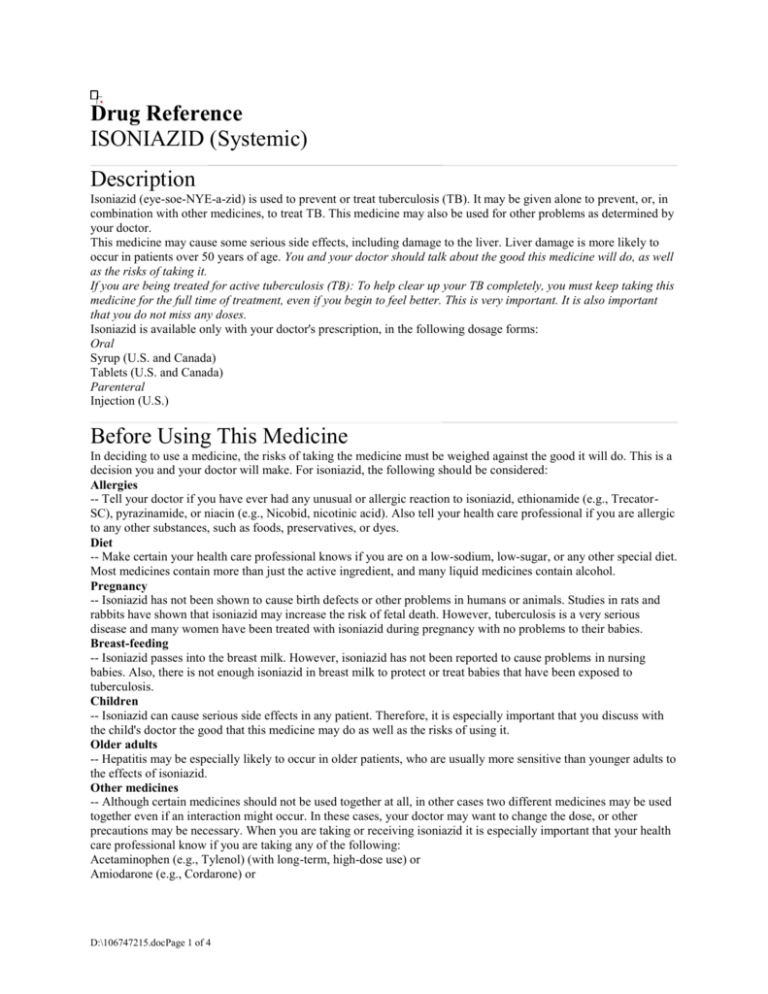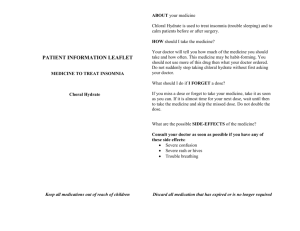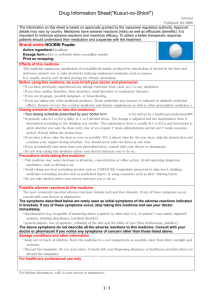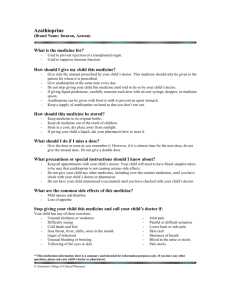
Drug Reference
ISONIAZID (Systemic)
Description
Isoniazid (eye-soe-NYE-a-zid) is used to prevent or treat tuberculosis (TB). It may be given alone to prevent, or, in
combination with other medicines, to treat TB. This medicine may also be used for other problems as determined by
your doctor.
This medicine may cause some serious side effects, including damage to the liver. Liver damage is more likely to
occur in patients over 50 years of age. You and your doctor should talk about the good this medicine will do, as well
as the risks of taking it.
If you are being treated for active tuberculosis (TB): To help clear up your TB completely, you must keep taking this
medicine for the full time of treatment, even if you begin to feel better. This is very important. It is also important
that you do not miss any doses.
Isoniazid is available only with your doctor's prescription, in the following dosage forms:
Oral
Syrup (U.S. and Canada)
Tablets (U.S. and Canada)
Parenteral
Injection (U.S.)
Before Using This Medicine
In deciding to use a medicine, the risks of taking the medicine must be weighed against the good it will do. This is a
decision you and your doctor will make. For isoniazid, the following should be considered:
Allergies
-- Tell your doctor if you have ever had any unusual or allergic reaction to isoniazid, ethionamide (e.g., TrecatorSC), pyrazinamide, or niacin (e.g., Nicobid, nicotinic acid). Also tell your health care professional if you are allergic
to any other substances, such as foods, preservatives, or dyes.
Diet
-- Make certain your health care professional knows if you are on a low-sodium, low-sugar, or any other special diet.
Most medicines contain more than just the active ingredient, and many liquid medicines contain alcohol.
Pregnancy
-- Isoniazid has not been shown to cause birth defects or other problems in humans or animals. Studies in rats and
rabbits have shown that isoniazid may increase the risk of fetal death. However, tuberculosis is a very serious
disease and many women have been treated with isoniazid during pregnancy with no problems to their babies.
Breast-feeding
-- Isoniazid passes into the breast milk. However, isoniazid has not been reported to cause problems in nursing
babies. Also, there is not enough isoniazid in breast milk to protect or treat babies that have been exposed to
tuberculosis.
Children
-- Isoniazid can cause serious side effects in any patient. Therefore, it is especially important that you discuss with
the child's doctor the good that this medicine may do as well as the risks of using it.
Older adults
-- Hepatitis may be especially likely to occur in older patients, who are usually more sensitive than younger adults to
the effects of isoniazid.
Other medicines
-- Although certain medicines should not be used together at all, in other cases two different medicines may be used
together even if an interaction might occur. In these cases, your doctor may want to change the dose, or other
precautions may be necessary. When you are taking or receiving isoniazid it is especially important that your health
care professional know if you are taking any of the following:
Acetaminophen (e.g., Tylenol) (with long-term, high-dose use) or
Amiodarone (e.g., Cordarone) or
D:\106747215.docPage 1 of 4
Anabolic steroids (nandrolone \[e.g., Anabolin\], oxandrolone \[e.g., Anavar\], oxymetholone \[e.g., Anadrol\],
stanozolol \[e.g., Winstrol\]) or
Androgens (male hormones) or
Antithyroid agents (medicine for overactive thyroid) or
Carmustine (e.g., BiCNU) or
Chloroquine (e.g., Aralen) or
Dantrolene (e.g., Dantrium) or
Daunorubicin (e.g., Cerubidine) or
Disulfiram (e.g., Antabuse) or
Divalproex (e.g., Depakote) or
Estrogens (female hormones) or
Etretinate (e.g., Tegison) or
Gold salts (medicine for arthritis) or
Hydroxychloroquine (e.g., Plaquenil) or
Mercaptopurine (e.g., Purinethol) or
Methotrexate (e.g., Mexate) or
Methyldopa (e.g., Aldomet) or
Naltrexone (e.g., Trexan) (with long-term, high-dose use) or
Oral contraceptives (birth control pills) containing estrogen or
Other anti-infectives by mouth or by injection (medicine for infection) or
Phenothiazines (acetophenazine \[e.g., Tindal\], chlorpromazine \[e.g., Thorazine\], fluphenazine \[e.g., Prolixin\],
mesoridazine \[e.g., Serentil\], perphenazine \[e.g., Trilafon\], prochlorperazine \[e.g., Compazine\], promazine
\[e.g., Sparine\], promethazine \[e.g., Phenergan\], thioridazine \[e.g., Mellaril\], trifluoperazine \[e.g., Stelazine\],
triflupromazine \[e.g., Vesprin\], trimeprazine \[e.g., Temaril\]) or
Plicamycin (e.g., Mithracin) or
Valproic acid (e.g., Depakene) -- These medicines may increase the chance of liver damage if taken with isoniazid
Carbamazepine (e.g., Tegretol) or
Phenytoin (e.g., Dilantin) -- These medicines may increase the chance of liver damage if taken with isoniazid. There
may also be an increased chance of side effects of carbamazepine and phenytoin
Disulfiram (e.g., Antabuse) -- This medicine may increase the chance of liver damage and side effects, such as
dizziness, lack of coordination, irritability, and trouble in sleeping
Ketoconazole (e.g., Nizoral) or
Rifampin (e.g., Rifadin) -- Use of these medicines with isoniazid can lower the blood levels of ketoconazole or
rifampin, decreasing their effects
Other medical problems
-- The presence of other medical problems may affect the use of isoniazid. Make sure you tell your doctor if you
have any other medical problems, especially:
Alcohol abuse (or history of) or
Liver disease -- There may be an increased chance of hepatitis with daily drinking of alcohol or in patients with liver
disease
Kidney disease (severe) -- There may be an increased chance of side effects in patients with severe kidney disease
Seizure disorders such as epilepsy -- There may be an increased chance of seizures (convulsions) in some patients
Proper Use of This Medicine
If you are taking isoniazid by mouth and it upsets your stomach, take it with food. Antacids may also help.
However, do not take aluminum-containing antacids within 1 hour of taking isoniazid. They may keep this medicine
from working properly.
For patients taking the oral liquid form of isoniazid:
Use a specially marked measuring spoon or other device to measure each dose accurately. The average household
teaspoon may not hold the right amount of liquid.
To help clear up your tuberculosis (TB) completely, it is very important that you keep taking this medicine for the
full time of treatment, even if you begin to feel better after a few weeks. You may have to take it every day for as
long as 6 months to 2 years. It is important that you do not miss any doses.
Your doctor may also want you to take pyridoxine (e.g., Hexa-Betalin, vitamin B6) every day to help prevent or
lessen some of the side effects of isoniazid. This is not usually needed in children, who receive enough pyridoxine in
D:\106747215.docPage 2 of 4
their diet. If it is needed, it is very important to take pyridoxine every day along with this medicine. Do not miss any
doses.
Dosing
-- The dose of isoniazid will be different for different patients. Follow your doctor's orders or the directions on the
label. The following information includes only the average d oses of isoniazid. If your dose is different, do not
change it unless your doctor tells you to do so.
The number of tablets or teaspoonfuls of syrup that you take depends on the strength of the medicine.
For oral dosage forms (tablets, syrup):
-- For prevention of tuberculosis:
Adults and teenagers -- 300 milligrams (mg) once a day.
Children -- Dose is based on body weight. The usual dose is 10 mg per kilogram (kg) (4.5 mg per pound) of body
weight, up to 300 mg, once a day.
-- For treatment of tuberculosis:
Adults and teenagers -- 300 mg once a day; or 15 mg per kg (6.8 mg per pound) of body weight, up to 900 mg, two
times a week or three times a week, depending on the schedule your doctor chooses for you.
Children -- Dose is based on body weight. The usual dose is 10 to 20 mg per kg (4.5 to 9.1 mg per pound) of body
weight, up to 300 mg, once a day; or 20 to 40 mg per kg (9.1 to 18.2 mg per pound) of body weight, up to 900 mg,
two times a week or three times a week, depending on the schedule your doctor chooses for you.
For injection dosage form:
-- For prevention of tuberculosis:
Adults and teenagers -- 300 mg once a day.
Children -- Dose is based on body weight. The usual dose is 10 mg per kg (4.5 mg per pound) of body weight, up to
300 mg, once a day.
-- For treatment of tuberculosis:
Adults and teenagers -- 300 mg once a day; or 15 mg per kg (6.8 mg per pound) of body weight, up to 900 mg, two
times a week or three times a week, depending on the schedule your doctor chooses for you.
Children -- Dose is based on body weight. The usual dose is 10 to 20 mg per kg (4.5 to 9.1 mg per pound) of body
weight, up to 300 mg, once a day; or 20 to 40 mg per kg (9.1 to 18.2 mg per pound) of body weight, up to 900 mg,
two times a week or three times a week, depending on the schedule your doctor chooses for you.
Missed dose
-- If you miss a dose of this medicine, take it as soon as possible. However, if it is almost time for your next dose,
skip the missed dose and go back to your regular dosing schedule. Do not double doses.
Storage
-- To store this medicine:
Keep out of the reach of children.
Store away from heat and direct light.
Do not store the tablet form of this medicine in the bathroom, near the kitchen sink, or in other damp places. Heat or
moisture may cause the medicine to break down.
Keep the oral liquid form of this medicine from freezing.
Do not keep outdated medicine or medicine no longer needed. Be sure that any discarded medicine is out of the
reach of children.
Precautions While Using This Medicine
It is very important that your doctor check your progress at regular visits. Also, check with your doctor immediately
if blurred vision or loss of vision, with or without eye pain, occurs during treatment. Your doctor may want you to
have your eyes checked by an ophthalmologist (eye doctor).
If your symptoms do not improve within 2 to 3 weeks, or if they become worse, check with your doctor.
Certain foods such as cheese (Swiss or Cheshire) or fish (tuna, skipjack, or Sardinella) may rarely cause reactions in
some patients taking isoniazid. Check with your doctor if redness or itching of the skin, hot feeling, fast or pounding
heartbeat, sweating, chills or clammy feeling, headache, or lightheadedness occurs while you are taking this
medicine.
Liver problems may be more likely to occur if you drink alcoholic beverages regularly while you are taking this
medicine. Also, the regular use of alcohol may keep this medicine from working properly. Therefore, you should
strictly limit the amount of alcoholic beverages you drink while you are taking this medicine.
D:\106747215.docPage 3 of 4
If this medicine causes you to feel very tired or very weak; or causes clumsiness; unsteadiness; a loss of appetite;
nausea; numbness, tingling, burning, or pain in the hands and feet; or vomiting, check with your doctor
immediately. These may be early warning signs of more serious liver or nerve problems that could develop later.
For diabetic patients:
This medicine may cause false test results with some urine sugar tests. Check with your doctor before changing your
diet or the dosage of your diabetes medicine.
Side Effects of This Medicine
Along with its needed effects, a medicine may cause some unwanted effects. Although not all of these side effects
may occur, if they do occur they may need medical attention.
Check with your doctor immediately if any of the following side effects occur:
More common
Clumsiness or unsteadiness; dark urine; loss of appetite; nausea or vomiting; numbness, tingling, burning, or pain in
hands and feet; unusual tiredness or weakness; yellow eyes or skin
Rare
Blurred vision or loss of vision, with or without eye pain; convulsions (seizures); fever and sore throat; joint pain;
mental depression; mood or other mental changes; skin rash; unusual bleeding or bruising
Other side effects may occur that usually do not need medical attention. These side effects may go away during
treatment as your body adjusts to the medicine. However, check with your doctor if any of the following side effects
continue or are bothersome:
More common
Diarrhea; stomach pain
For injection form
Irritation at the place of injection
Dark urine and yellowing of the eyes or skin (signs of liver problems) are more likely to occur in patients over 50
years of age.
Other side effects not listed above may also occur in some patients. If you notice any other effects, check with your
doctor.
Some commonly used brand names are
In the U.S. -Laniazid
Nydrazid
Generic name product may also be available.
In Canada -Isotamine
PMS Isoniazid
Another commonly used name is INH.
From:USP Drug Information: Advice for the Patient
Copyright © 1997 The United States Pharmacopeial Convention, Inc. All rights reserved. USP DI * and Advice for
the Patient * are registered trademarks of The United States Pharmacopeial Convention, Inc.
TB/Manual/INHDrugReference.doc
Rev. 10/29/1999
D:\106747215.docPage 4 of 4








